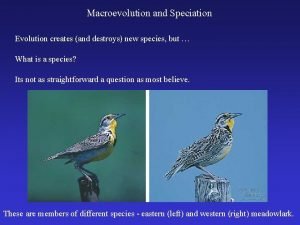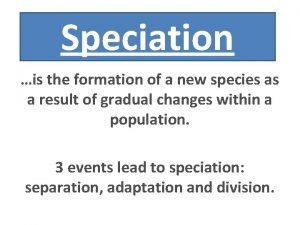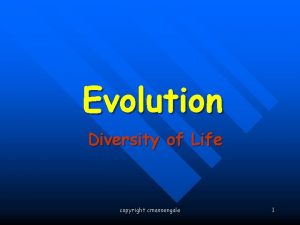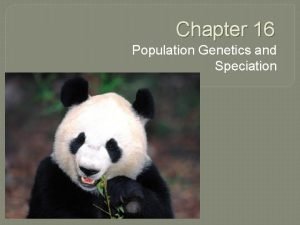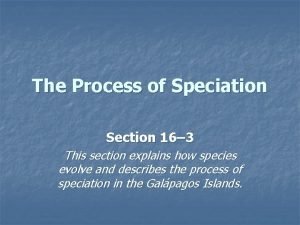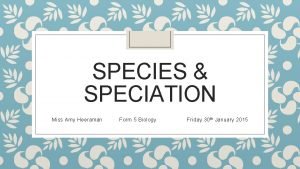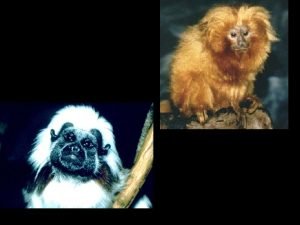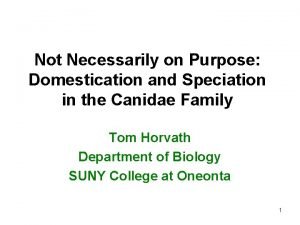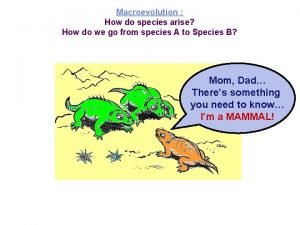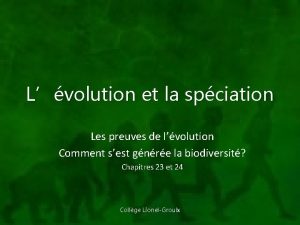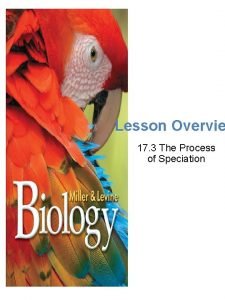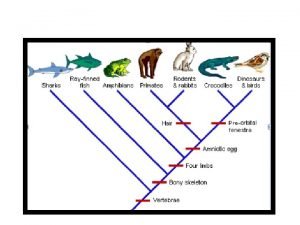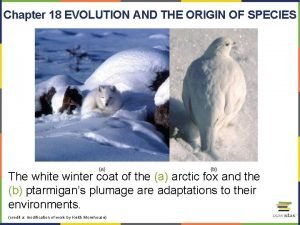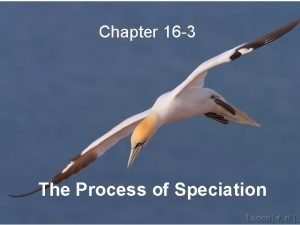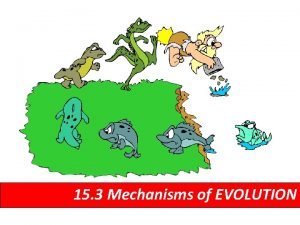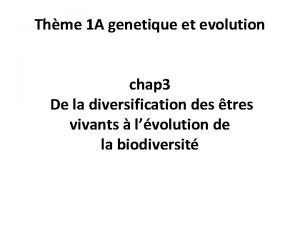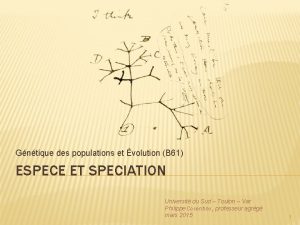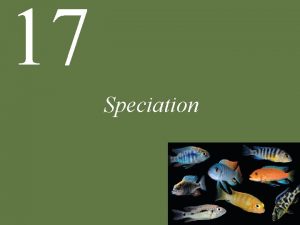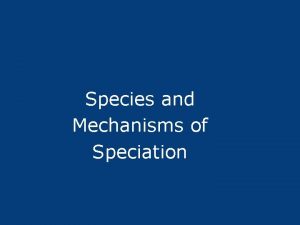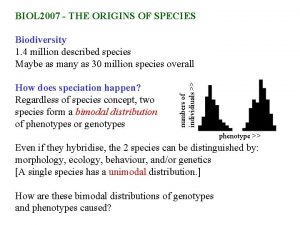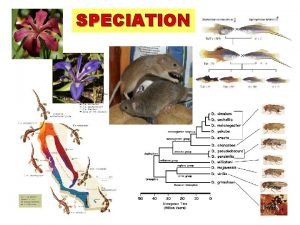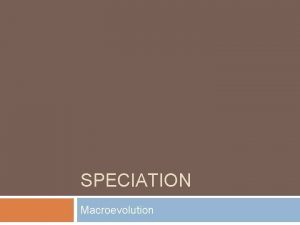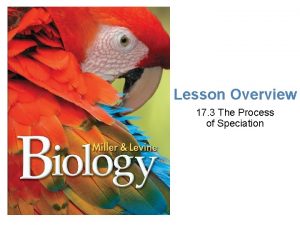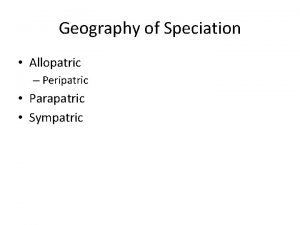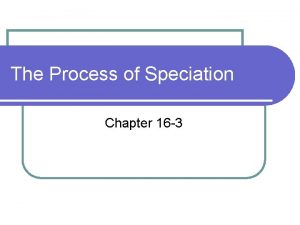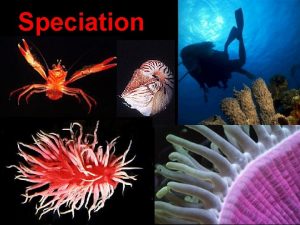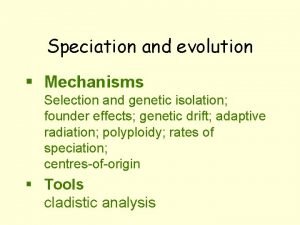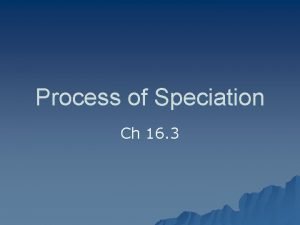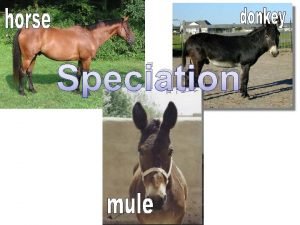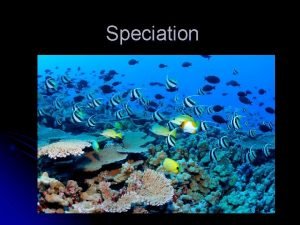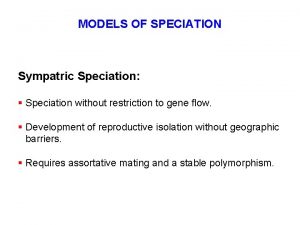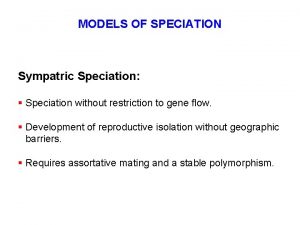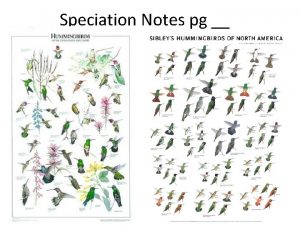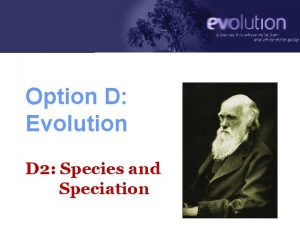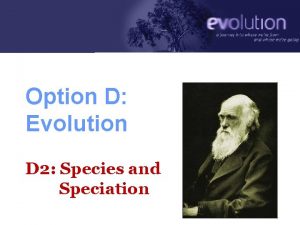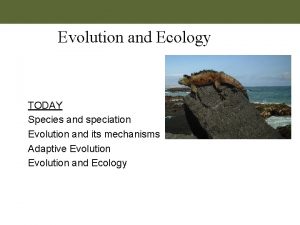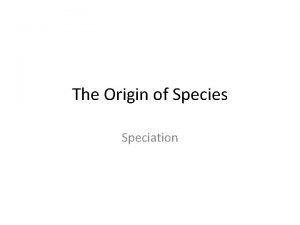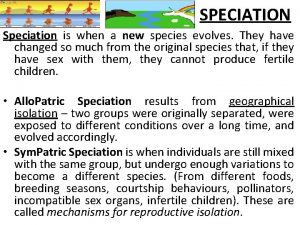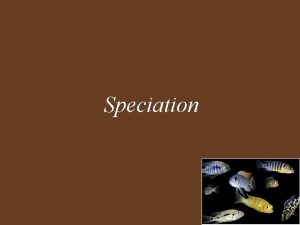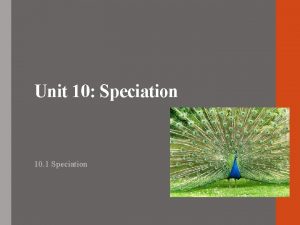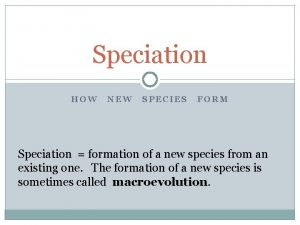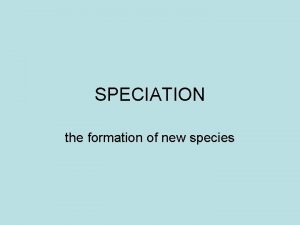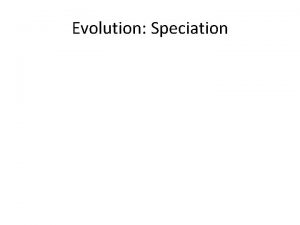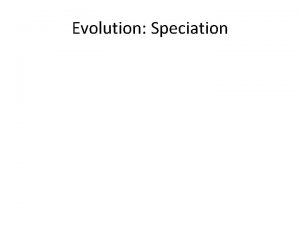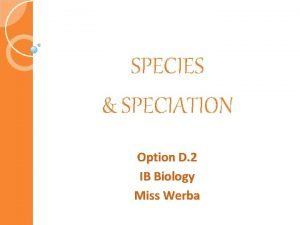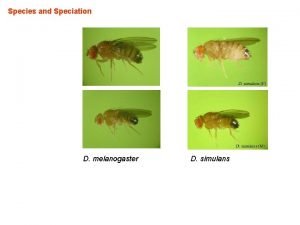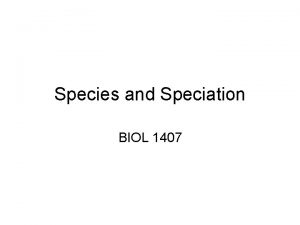Option D Evolution D 2 Species and Speciation





































- Slides: 37

Option D: Evolution D 2 Species and Speciation 1 IB Biology SFP - Mark Polko

ASSESSMENT STATEMENTS D. 2. 1 Define allele frequency and gene pool D. 2. 2 State that evolution involves a change in allele frequency in a population’s gene pool over a number of generations. D. 2. 3 Discuss the definition of the term species. D. 2. 4 Describe three examples of barriers between gene pools. D. 2. 5 Explain how polyploidy can contribute to speciation. D. 2. 6 Compare allopatric and sympatric speciation. D. 2. 7 Outline the process of adaptive radiation. D. 2. 8 Compare convergent and divergent evolution. D. 2. 9 Discuss ideas on the pace of evolution, including gradualism and punctuated equilibrium. D. 2. 10 Describe one example of transient polymorphism. D. 2. 11 Describe sickle-cell anemia as na example of balanced polymorphism. IB Biology SFP - Mark Polko 2

D. 2. 1 Define allele frequency and gene pool The physical characteristics in an organism are influenced by one or more genes together with the effects of the environment. Several forms of each gene may exist and these are termed alleles. The allele frequency is a measurement of the proportion of all copies of that gene that exist in that allelic form in that population. A gene pool is the total collection of alleles present in a sexually reproducing population. Gene pools constantly change: mutations are always occurring and introducing new genes into the gene pool. Alleles that confer a disadvantage are removed from the gene pool by natural selection. IB Biology SFP - Mark Polko 3

D. 2. 1 Define allele frequency and gene pool For example, in humans the frequency of a dominant allele is 99%. The recessive allele (at the same locus) has a frequency of 1%. Hence the dominant allele frequency is 0. 99 and the recessive allele frequency is 0. 01. Since the total population represents 100% or 1. 0 it can be seen that: dominant allele frequency + recessive allele frequency = 1 (This expression is only true if there are only two alleles in the population). 0. 99 + 0. 01 = 1 IB Biology SFP - Mark Polko 4

D. 2. 2 State that evolution involves a change in allele frequency in a population’s gene pool over a number of generations. A population whose gene pool shows directional change from one generation to the next is undergoing an evolutionary process. New combinations of alleles produce unique genotypes which, when expressed as phenotypes, experience natural selection which determines which genes are passed on to the next generation. IB Biology SFP - Mark Polko 5

D. 2. 3 Discuss the definition of the term species. The most widely used definition is the genetic definition where the individuals of a species form a single gene pool. It should be noted that, unlike other groups used for classification, for example, class and genus, species are real biological units. The individuals which form a species have a relationship which is different from that between other taxonomic groups, for example, genus and kingdom. IB Biology SFP - Mark Polko 6

D. 2. 3 Discuss the definition of the term species. Biologists generally use either the morphological or the cladistic definition of species. Biologists also have to cope with the evolution of species: a species may gradually or rapidly evolve into one or several species via a series of intermediate forms. The genetic definition of species applies well to many multicellular organisms, but there are situations where it is not applicable. • It only applies to sexually reproducing organisms and cannot be applied to single-celled organisms. • Some hybrids, for example, mules and tigrons (female lion/male tiger), cannot mate with one of their own kind, for example, a mule with a mule, but sometimes produce offspring when mated with members of one of the parent species, for example, a ligron with a liger (male lion/female tiger). IB Biology SFP - Mark Polko 7

D. 2. 3 Discuss the definition of the term species. In a ring species members of adjacent populations interbreed successfully but members of widely separated populations do not. A ring species has an almost continuous set of intermediates between two distinct species, and these intermediates happen to be arranged in a ring. At most points in the ring, there is only one species; but there are two where the endpoints meet. The variation within a single species has produced differences as large as those between two separate species. IB Biology SFP - Mark Polko 8

D. 2. 3 Discuss the definition of the term species. • It may be a physically impossible for members of the same species to mate, for example, large and small breeds of the dog (Canis familiaris). IB Biology SFP - Mark Polko 9

D. 2. 4 Describe three examples of barriers between gene pools. Genetic isolation is the most common requirement for speciation. Geographical isolation of two populations of individuals may result in the accumulation of different allele frequencies and they may eventually behave as a separate species because of genetic incompatibility. The mechanisms for maintaining genetic isolation between populations of one species are known as reproductive isolating mechanisms. Prezygotic isolation means that zygotes are not formed because gametes do not meet and fertilise. However, if zygotes are formed, they may not develop as a result of postzygotic isolation. IB Biology SFP - Mark Polko 10

D. 2. 4 Describe three examples of barriers between gene pools. Temporal isolation In California in the United States Pinus radiata (Monterey pine) flowers in February, whereas Pinus attenuata (knob cone pine) flowers in April. The Knobcone pine may hybridise with the Bishop pine and the Monetery Pine. In North America, four frog species of the genus Rana differ in the time of their peak breeding activity, LINK IB Biology SFP - Mark Polko 11

D. 2. 4 Describe three examples of barriers between gene pools. Ecological Isolation This is not very common in animals but is widespread among plants. Closely related species often differ significantly in their flowering seasons, or in their requirements for soil type or climate. For example, the sea campion, Silene maritima, grows on rocky beaches, while the bladder campion, Silene vulgaris, grows in meadows. Breeding between the species is rare, even though the hybrids formed are fertile. Another example of ecological isolation is provided by the genus Viola: Viola arvensis grows on soils rich in calcium carbonate, whereas Viola tricolor prefers acidic soils. The lion and tiger had overlapping ranges in India until 150 years ago, but the lion lived in open grassland the tiger in forest. Consequently, the two species did not hybridise in nature (although they sometimes do in zoos to form ‘tigrons’ and ‘ligers’). IB Biology SFP - Mark Polko 12

D. 2. 4 Describe three examples of barriers between gene pools. Behavioural Isolation A wide range of behavioural mechanisms have evolved which help to keep species separate. A number of animals utilise chemical stimuli to bring the mating partners together. Many female moths release small amounts of sexual pheromones. These secretions are released into the air and are detected by the antennae of the males. Each species of moth produces its own distinctive pheromone. Auditory and visual signals may also play an important role in maintaining reproductive isolation. A number of insects, for example, crickets and cicadas, seek out males, which produce characteristic species-specific songs. The sounds are produced when one part of the body is rubbed rapidly against another. Bird songs also serve similar functions, but are also involved in defending territory. LINK IB Biology SFP - Mark Polko 13

D. 2. 4 Describe three examples of barriers between gene pools. Hybrid inviability Hybrids formed from the fusion of gametes from different species are often sterile because they cannot produce gametes. For example, in a cross between a male horse (2 n=64) and a female donkey (2 n=62), the resulting mule has 63 chromosomes. The chromosomes do not pair up during meiosis and the mule is sterile. IB Biology SFP - Mark Polko 14

D. 2. 5 Explain how polyploidy can contribute to speciation. Polyploidy is the condition of some organisms whose cells contain more than two homologous sets of chromosomes. Polyploid types are termed according to the number of chromosome sets in the nucleus: triploid (three sets; 3×), tetraploid (four sets; 4×), pentaploid (five sets; 5×), hexaploid (six sets; 6×) and so on. Polyploidy is well tolerated in many species of plants. Polyploidy is a form of sympatric speciation (see Topic D. 2. 6. ). Polyploidy does not add new genes to the gene pool, but gives rise to new combinations of genes. Molecular biology studies have revealed that after polyploidy formation very rapid changes in gene structure and gene expression can occur. Get the T-shirt! IB Biology SFP - Mark Polko 15

D. 2. 5 Explain how polyploidy can contribute to speciation. The relatively rare survival of polyploids among animals is because the increased number of chromosomes in polyploids makes normal gamete formation during meiosis extremely improbable. Since many plants are capable of asexual reproduction they are able to reproduce despite being polyploid. In addition polyploidy would disrupt the pairing of the sex chromosomes which occurs in insects, birds and mammals. This is not an issue in plants since they lack separate sexes. In addition, most animals cannot self fertilise (exceptions include nematodes) or reproduce asexually (exceptions include ciliates) and hence it is a relatively rare form of speciation in animals. However, polyploidy occurs in some animals, such as goldfish, salamaders and salmon. IB Biology SFP - Mark Polko 16

D. 2. 5 Explain how polyploidy can contribute to speciation. Many species of common garden flowers, for example, tulips, crocuses, irises and primroses have been created by an artificial process of fertilisation. The chemical colchicine is used to induce polyploidy by blocking formation of the spindle. IB Biology SFP - Mark Polko 17

D. 2. 5 Explain how polyploidy can contribute to speciation. There are two forms of polyploidy: • autopolyploidy • allopolyploidy Autopolyploidy may occur naturally or artificially as a result of an increase in the number of chromosomes within the same species. For example, if chromosomes undergo replication and the chromatids separate but the cytoplasm fails to cleave, a tetraploid (4 n) cell is produced from a diploid cell. The amount of cytoplasm in the tetraploid cells increases to maintain the ratio of the nucleus to the cytoplasm size. This leads to an increase in the size of the entire plant or a specific part of it. Colchicine, extracted from the corm of the autumn crocus (Colchicum), can be used to induce autopolyploidy. IB Biology SFP - Mark Polko 18

D. 2. 5 Explain how polyploidy can contribute to speciation. Allopolyploidy This form of polyploidy arises when the chromosome number in a sterile hybrid becomes doubled and produces fertile hybrids. F 1 hybrids produced from different species are usually sterile since their chromosomes cannot form homologous pairs during meiosis. This is termed hybrid sterility. However, if multiples of the original haploid number of chromosomes for example, 2 (n 1 + n 2), 3 (n 1 + n 2) etc, (where n 1 and n 2 represent the haploid numbers of the parent species) occur, a new species is produced which is fertile with polyploids that genetically resemble itself. IB Biology SFP - Mark Polko 19

D. 2. 6 Compare allopatric and sympatric speciation. Speciation is the process by which one or more species arise from previously existing species. A single species may give rise to a new species (intraspecific speciation), or two different species may give rise to a new species (interspecific hybridisation). If intraspecific speciation occurs whilst the populations are physically separated it is termed allopatric speciation. If the process of speciation occurs while the populations are occupying the same geographical area or range it is termed sympatric speciation. LINK IB Biology SFP - Mark Polko 20

D. 2. 6 Compare allopatric and sympatric speciation. Allopatric speciation occurs when a geographical barrier, for example, a mountain range, sea or river produces a barrier to gene flow because of spatial separation. Adaptations to a new environment (or random drift in small populations) leads to changes in allele and genotype frequencies. Prolonged separation of populations for many generations may result in two sub-populations becoming genetically isolated even if the barrier was removed. In other words, speciation can occur through random forces, rather than through the action of natural selection. IB Biology SFP - Mark Polko 21

D. 2. 6 Compare allopatric and sympatric speciation. Parapatric speciation is discussed later in Topic D. 2. 9. It is a form of speciation in which the new species is formed within a single population which is within the ancestral species’ geographical range. IB Biology SFP - Mark Polko 22

D. 2. 7 Outline the process of adaptive radiation. When a group of organisms share a homologous structures (see Topic D. 5. 6) which are differentiated to perform a variety of different functions, it illustrates a principle known as adaptive radiation. Homologous structures have the same genetic determinants. They should be contrasted with structures which may superficially resemble each other but have risen through convergence; these are ‘analogues’. For example, all organisms that belong to a particular taxonomic class share a number of modified features. These variations in shared features adapt them to particular ecological habitats. IB Biology SFP - Mark Polko 23

D. 2. 7 Outline the process of adaptive radiation. The mouthparts of insects consist of the same basic structures: a labrum (upper lip), a pair of mandibles, a hypopharynx (floor of mouth), a pair of maxillae. Insects are able to feed on a variety of different food sources, as shown below, because some of the mouth part structures are enlarged and modified, but others are reduced or even lost. The high degree of adaptive radiation in the insects (insecta) has allowed the class to occupy a huge range of ecological niches. The same happened with the Hawaiian honeycreepers. IB Biology SFP - Mark Polko 24

D. 2. 8 Compare convergent and divergent evolution. Convergent evolution describes the process where distantly related organisms evolve similar traits as they adapt to similar environments or ecological niches. Biological adaptations that are the result of convergent evolution are termed analogous structures. Flying squirrel (North America) IB Biology SFP - Mark Polko Sugar glider (Australia) 25

D. 2. 8 Compare convergent and divergent evolution. Divergent evolution occurs when two or more adaptations have a common evolutionary origin, but have diverged over evolutionary time. This is also known as adaptive evolution. Divergent evolution and convergent evolution are distinct. In the case of divergent evolution, similarity is due to the common origin. In contrast, convergent evolution arises when there is pressure from natural selection toward a similar ‘solution’, even though the structure or function has evolved independently. IB Biology SFP - Mark Polko 26

D. 2. 8 Compare convergent and divergent evolution. Parallel evolution is a type of evolution in which two species maintain the same degree of similarity while each undergoes evolutionary change along an independent path. Lake Tanganyika Lake Malawi IB Biology SFP - Mark Polko 27

D. 2. 8 Compare convergent and divergent evolution. For example, the vertebrate limb is an example of divergent evolution. The limb in many different species has a common origin, but has diverged somewhat in overall structure and function. For example, the forelimbs of a whale are used as paddles, the forelimbs of birds for flight and the hand of humans for grasping and manipulating objects. However, the limbs of all vertebrates develop from the same embryonic tissue and fit a ‘common plan’ known as the pentadactyl limb. IB Biology SFP - Mark Polko 28

D. 2. 9 Discuss ideas on the pace of evolution, including gradualism and punctuated equilibrium. Punctuated equilibrium claims that many species will show stasis, that is, little or no evolutionary change through much of their geological history. This theory was an attempt to account for many observed gaps in the fossil record. Punctuated equilibrium claims that rapid evolutionary change occurs during speciation when a species splits into two species. During these punctuation events the rate of change is relatively high. Gradualism Punctuated equilibrium is contrasted with phyletic gradualism which suggests that most evolutionary change at a relatively slow, but not necessarily uniform rate and that one species is gradually transformed into another species. IB Biology SFP - Mark Polko 29

D. 2. 9 Discuss ideas on the pace of evolution, including gradualism and punctuated equilibrium. IB Biology SFP - Mark Polko 30

Task for now: Make a Glossary of all term of this unit. IB Biology SFP - Mark Polko 31

D. 2. 10 Describe one example of transient polymorphism. Polymorphism or genetic polymorphism plays a significant role in the process of natural selection. It is defined as the existence of two or more forms of the same species within the population. The concept can be applied to biochemical, morphological and behavioural characteristics. There are two forms of genetic polymorphism: transient polymorphism and balanced polymorphism. A transient polymorphism refers to a polymorphism in which one allele is in the process of displacing another. A polymorphism that is maintained by selection in favour of the heterozygote phenotype, is called a balanced polymorphism. IB Biology SFP - Mark Polko 32

D. 2. 10 Describe one example of transient polymorphism. One of the most famous examples of evolutionary change is the response of moth species to natural selection produced by the atmospheric pollution during the Industrial Revolution. This is known as industrial melanism and the most closely studied species is the British peppered moth Biston betularia. Until around 1840, all individuals of the species of the moth were creamy-white with black dots and darkly shaded areas. In 1848 a black form or variety was recorded in Manchester and by 1895, most of the peppered moth population was black. The black or melanic form had presumably occurred in previous populations, due to recurring mutation. However, with the change in the environment it had a strong selective advantage in industrial areas due to its phenotype. The melanic form is due to the presence of a single dominant allele. Remember this animation IB Biology SFP - Mark Polko 33

D. 2. 11 Describe sickle-cell anemia as an example of balanced polymorphism. Balanced polymorphism occurs when two different forms or varieties coexist in the same population in a stable environment. The human condition of sickle-cell anaemia is an example of a mutation that causes substitution. The mutation affects a single base in one of the genes encoding haemoglobin. Specifically, the base sequence of the codon for a single amino acid in the beta protein chains gives rise to the production of sickle-cell haemoglobin. Red blood cells containing haemoglobin-S are distorted and appear sickle-shaped. The physiological consequence is that the red blood cells carry less oxygen leading to anaemia. Homozygous patients (Hb. S) suffer from physical weakness and have a higher risk of heart and kidney failure at an early age. They have a lower life expectance. IB Biology SFP - Mark Polko 34

D. 2. 11 Describe sickle-cell anemia as an example of balanced polymorphism. In the heterozygous condition (Hb Hb. S) patients exhibit a condition called sicklecell trait. The red blood cells appear normal and only about half of the haemoglobin is abnormal. However, they become sickle-shaped during heavy exercise. This produces only mild anaemia and in Africa and Asia it prevents carriers of the trait from contracting malaria. This is because Plasmodium, a protozoan (remember from Topic F. 6. 9. ), does not have time to complete its life history inside the short lived red blood cells containing the mutant or abnormal haemoglobin (Hb. S). Sickle-cell anaemia is an example of balancing selection and balanced polymorphism. The allele frequency of sickle-cell anaemia is maintained by a mechanism known as heterozygote advantage. The wild type homozygotes suffer malaria and some die. The other homozygotes are severe anaemics and die. The heterozygotes survive and necessarily will produce more of each homozygote in the next generation. IB Biology SFP - Mark Polko 35

D. 2. 11 Describe sickle-cell anemia as an example of balanced polymorphism. Balancing selection refers to forms of natural selection which work to maintain genetic polymorphisms (or multiple alleles) within a population. A balanced polymorphism occurs when balancing selection within a population is able to maintain stable frequencies of two or more phenotypic forms. IB Biology SFP - Mark Polko 36

Option D: Evolution D 2 Species and Speciation 37 IB Biology SFP - Mark Polko
 Antelope squirrel allopatric speciation
Antelope squirrel allopatric speciation Speciation, or the formation of new species, is
Speciation, or the formation of new species, is Konvergensi option adalah
Konvergensi option adalah Option a option b
Option a option b Why is the saguaro cactus a keystone species
Why is the saguaro cactus a keystone species Copyright
Copyright Evolution of species 2
Evolution of species 2 Population genetics and speciation worksheet answer key
Population genetics and speciation worksheet answer key Section 16–3 the process of speciation
Section 16–3 the process of speciation Ecological speciation
Ecological speciation How does speciation occur
How does speciation occur Allopatric speciation example
Allopatric speciation example Factors affecting gene frequency slideshare
Factors affecting gene frequency slideshare Cladogram for dogs
Cladogram for dogs Hybrid fertility
Hybrid fertility La spéciation
La spéciation Process of speciation
Process of speciation Speciation def
Speciation def Ecological speciation
Ecological speciation Origin of species chapter 18
Origin of species chapter 18 Section 16–3 the process of speciation
Section 16–3 the process of speciation Sympatric species
Sympatric species Ecureuil antilope grand canyon
Ecureuil antilope grand canyon Scala naturae
Scala naturae Example of parapatric speciation
Example of parapatric speciation Speciation
Speciation Prezygotic barriers
Prezygotic barriers Sympatric speciation
Sympatric speciation Ring species
Ring species Speciation process
Speciation process Speciation process
Speciation process Parapatric speciation
Parapatric speciation Sympatric speciation
Sympatric speciation Section 16-3 the process of speciation answer key
Section 16-3 the process of speciation answer key Speciation scenarios reinforcement answer key
Speciation scenarios reinforcement answer key Parapatric speciation
Parapatric speciation Speciation
Speciation 16-3 the process of speciation
16-3 the process of speciation
